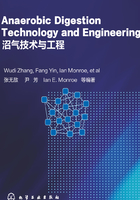
2.5 Fermentative Bacteria
The organic compounds like carbohydrate, proteins and fats in biogas fermenting material, by action of liquefaction of non-methane-yielding microbes (exoenzymes), are splitted into soluble, simpler compounds after entering bacterial cells. These simpler compounds have undergone various decomposition yielding organic acids, alcohol, ketones and CO2, H2, NH3, H2S etc. The methane-producing bacteria can't directly utilize organic compounds to form methane unless they are degraded to simple compounds of smaller molecular compounds by non-methaneproducing bacteria. Non-methane-producing microbes, therefore, are of importance in biogas fermentation.
As mentioned above, according to their physiology, non-methane-producing bacteria are grouped into 7 classes, which are of different functions.
2.5.1 Cellulose-splitting Bacteria
Cellulose-splitting bacteria catabolize cellulose to form smaller compounds of low molecular weight, which can be utilized by methane-producing bacteria to yield methane.
In nature, there exists a large amount of fermenting resources containing cellulose, especially in straw and human or animal wastes in rural areas. As to biogas fermentation, cellulose decomposition affects directly methane formation, in other words, the speed of cellulose decomposition is a limiting factor in the later steps of biogas fermentation. Cellulose-splitting bacteria, therefore, are the group of importance in non-methane-producing bacteria.
Two strains of cellulose-splitting bacteria grown on culture medium containing cellulose, yeast extract and phosphate buffer solution under an atmosphere of ammonium were studied by Hungate and the result revealed that these bacteria were similar to Bacteroides succinogenes. Under anaerobic biogas fermentation conditions, Clostridium omelianskii, Cl. thermoceilum, Cl. dissolvents and so on, are all able to split cellulose.
2.5.2 Semi-cellulose-splitting Bacteria
The action of semi-cellulose-splitting bacteria is to split semi-cellulose to produce xylose, arabinose, galactose and mannose.
The amount of semi-cellulose in biogas fermenting material is only next to that of cellulose, so semi-cellulose-splitting bacteria are also of importance in biogas fermentation. During digesting period of pigsty waste, Shaw discovered the degradation of semi-cellulose was predominant, and the work of Provincial Institute of Microbiology, Hebei, China, revealed that within one month after the set-up of a digester, the speed of semi-cellulose decomposition was faster than that of cellulose.
The amount of semi-cellulose-splitting bacteria in a digestion of pigsty waste was similar to that of cellulose-splitting bacteria.The former belong to Bacteroides ruminicola.
2.5.3 Starch-splitting Bacteria
The action of starch-splitting bacteria is to catabolize starch to form glucose.
The amount of starch-splitting bacteria present in the fermenting resources is related to their starch content. For example, there are more starch in pigsty waste, and the starch-splitting bacteria present are plenty in this fermenting process. In this case,the bacteria are mainly bacteroides,Gram's negative cocci and bacterium butylicum.
In 1979,Clostridium acetobutylicum,which has a strong power to catabolize starch to yield aceto-butanol, butyric acid, acetic acid and hydrogen, was isolated from a digester of underground sludge by Chengdu Institute of Biology, Chengdu Branch of Chinese Academy of Science.
2.5.4 Protein-splitting Bacteria
Protein-splitting bacteria catabolize protein to yield amino acids, which are further degraded into organic acids, thio-alcohols, ammonium, and hydrogen sulfide.
The protein-splitting bacteria present in a biogas digester are mainly Gram's positive ones predominant with Clostridium.
2.5.5 Fat-splitting Bacteria
The action of fat-splitting bacteria is to catabolize fats to produce short-chain fatty acid.
In general, the fat content of fermenting material in rural areas is very low while that of domestic sludges may be very high. Using sunflower oil concentration technique, Toerien pointed out: vibrio is the richest among fat splitting bacteria in anaerobic fermentation. Besides, there are some Bacillus, Alcaligenes and monas.